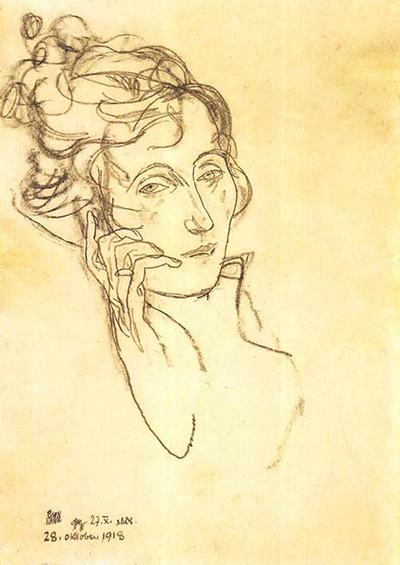Egon sketched this drawing of his dying Edith Schiele as he lay dying himself, and passed away just a few days later. This was the perfect theme for an artist who worked from his emotions and also specialised in expressive portraits and self-portraits.
Her expression grave and loving, this sketch captures a heartbreaking and tragic, yet tender moment between husband and wife in their final hours. In his short life, Expressionist painter Egon Schiele managed to create some 3,000 works of art. One of the final and most poignant among them is this sketch of a dying Edith Schiele. Egon Schiele was born in Tulln, Austria in 1890. From a young age, he displayed a strong talent for drawing. This talent was nurtured by his father, Adolf, until his premature death of syphilis on Christmas in 1904. This loss at such a tender age, due to a sexually transmitted disease, combined with the poor health that was prevalent in the Schiele family had a profound effect on Egon.
Themes of sex and death would later be prominent in his works. Egon Schiele went on to paint some controversial pieces. In 1912, this resulted in the Sankt Polten trial and a prison sentence. Then, in 1915, Egon married Edith Harms, in spite of her disapproving family. Four days after the wedding, Schiele went to Prague to serve in WWI. After his time in prison and the military, his style evolved and softened. Much of that may also be thanks to his wife, Edith, who was now his primary model. In 1917, the Schieles returned to Vienna and were finally able to enjoy the successes of Egon's art career.
Sadly, that happiness would be cut short. The following year, his mentor, Gustav Klimt was dead. A few months later, Egon, Edith, and their unborn child fell victim to the Spanish Flu pandemic. On October 28, 1918, Edith Schiele passed away. Egon followed her to the grave three days later. This incredibly sad episode must be placed in context within the turmoil of life in Europe at this time - with 20m lives lost across the continent from disease, on top of the appaling consequences of WWI. It truly was one of the lowest moments in the history of this region and the Schiele family would become just another footnote to this tragic period. This drawing is beautifully simple, taking the artist's raw skills and combining them with the emotions of this time, giving us a highly personal insight into his life and personality.




